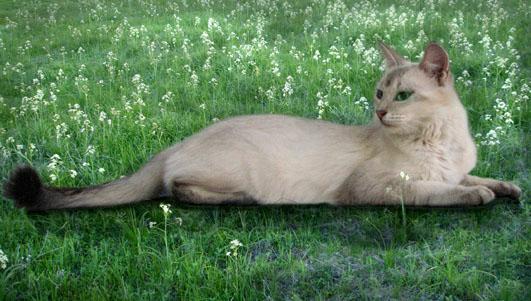The Official Cat Fanciers Association Standard For The Somali Cat
General:
The overall impression of the Somali is that of a well proportioned medium to large cat, firm muscular development, lithe, showing an alert, lively interest in all surroundings, with an even disposition and easy to handle. The cat is to give the appearance of activity, sound health, and general vigor.
Head:
A modified, slightly rounded wedge without flat planes; the brow, cheek, and profile lines all showing a gentle contour. A slight rise from the bridge of the nose to the forehead, which should be of good size with width between the ears flowing into the arched neck without a break.
Muzzle:
Shall follow gentle contours in conformity with the skull, as viewed from the front profile. Chin shall be full, neither undershot nor overshot, having a rounded appearance. The muzzle shall not be sharply pointed and there shall be no evidence of snippiness, foxiness, or whisker pinch. Allowance to be made for jowls in adult males.
Ears:
Large, alert, moderately pointed, broad, and cupped at the base. Ear set on a line towards the rear of the skull. The inner ear shall have horizontal tufts that reach nearly to the other side of the ear; tufts desirable.
Eyes:
Almond shaped, large, brilliant, and expressive. Skull aperture neither round nor oriental. Eyes accented by dark lidskin encircled by light colored area. Above each a short dark vertical pencil stroke with a dark pencil line continuing from the upper lid towards the ear.
Body:
Torso medium long, lithe, and graceful, showing well-developed muscular strength. Rib cage is rounded; back is slightly arched giving the appearance of a cat about to spring; flank level with no tuck up. Conformation strikes a medium between the extremes of cobby and svelte lengthy types.
Legs and Feet:
Legs in proportion to torso; feet oval and compact. When standing, the Somali gives the impression of being nimble and quick. Toes: five in front and four in back.
Tail:
Having a full brush, thick at the base, and slightly tapering. Length in balance with torso.
Coat:
Texture very soft to the touch, extremely fine and double coated. The more dense the coat, the better. Length: a medium length coat, except over shoulders, where a slightly shorter length is permitted. Preference is to be given to a cat with ruff and breeches, giving a full-coated appearance to the cat.
Penalize:
Color faults D cold grey or sandy tone to coat color; mottling or speckling on unticked areas. Pattern faults D necklaces, leg bars, tabby stripes, or bars on body; lack of desired markings on head and tail. Black roots on body.
Disqualify:
White locket or groin spot or white anywhere on body other than on the upper throat, chin, or nostril area. Any skeletal abnormality. Wrong color paw pads or nose leather. Any other colors than the four accepted colors. Unbroken necklace. Incorrect number of toes. Kinks in tail.
Coat Color:
Warm and glowing. Ticking: distinct and even, with dark colored bands contrasting with lighter colored bands on the hair shafts. Undercoat color clear and bright to the skin. Deeper color shades desired, however, intensity of ticking not to be sacrificed for depth of color. Preference given to cats UNMARKED on the undersides, chest, and legs; tail without rings.
Markings:
Darker shading along spine continuing through tip of tail; darker shading up the hocks, shading allowed at the point of the elbow; dark lines extending from eyes and brows, cheekbone shading, dots and shading on whisker pads are desirable enhancements, eyes accentuated by fine dark line, encircled by light colored area. Eye color: gold or green, the more richness and depth of color the better.
Ruddy:
Ground color burnt-sienna, ticked with various shades of darker brown or black; the extreme outer tip to be the darkest. Tail tipped with black. The underside and inside of legs to be a tint to harmonize with the ground color. Nose leather: tile red. Paw pads: black or dark brown, with black between toes, extending slightly beyond the paws.
Red:
Ground color rich, warm glowing red, ticked with chocolate-brown, the extreme outer tip to be darkest. Tail tipped with chocolate-brown. The underside and inside of legs to be a tint to harmonize with the ground color. Nose leather: rosy pink. Paw pads: pink, with chocolate-brown between toes, extending slightly beyond the paws.
Blue:
Ground color warm beige, ticked with slate blue, the extreme outer tip to be the darkest. Tail tipped with slate blue. The underside and inside of legs to be a tint to harmonize with the ground color. Nose leather: old rose. Paw pads: mauve, with slate blue between toes, extending slightly beyond the paws.
Fawn:
Ground color warm rose-beige, ticked with light cocoa-brown, the extreme outer tip to be the darkest. Tail tipped with light cocoa-brown. The underside and inside of legs to be a tint to harmonize with the ground color. Nose leather: salmon. Paw Pads: pink with light cocoa-brown between the toes, extending slightly beyond the paws.
(Please Note: the Somali is extremely slow in showing mature ticking and allowances should be made for kittens and young cats.)
Point Score
Head (25)
Skull ........... 6
Muzzle .......... 6
Ears ............ 7
Eye shape ...... 6
Body (25)
Torso ........... 10
Legs and feet ... 10
Tail ........... 5
Coat (20)
Texture ......... 10
Length .......... 10
Color (30)
Color ........... 10
Markings ........ 5
Ticking ......... 10
Eye color ....... 5




